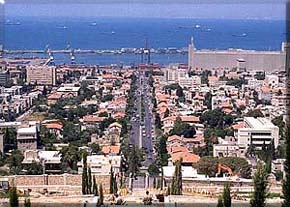|
|
Haifa
 Haifa is the major port in Israel and a main town of the north of the
country.
Haifa is the major port in Israel and a main town of the north of the
country.
The city, extending over the northwest flank of Mt. Carmel and overlooking
the Mediterranean, had a population of about 246,000 in the early 1990s.
The first settlement in the area was a small port town, founded in the
14th century b.c.e. (Late Bronze Age) and lasting a thousand years. Jewish
burial caves from the Roman period have been found nearby. The Talmud
mentions it as a fishing village, and it was later known as a shipbuilding
port.
There was a fierce battle every time the city changed hands. It was
ruled in turn by Persia, Byzantium, the Crusaders, Saladin, the Franks,
and Mamluks. Under Muslim rule there were only a few Jewish inhabitants,
apart from those who made pilgrimages to Elijah's cave on Mt. Carmel.
By the Ottoman conquest in 1516 Haifa was practically deserted, but its
population gradually grew to some 4,000 by 1798, when Rabbi Nahman of
Bratslav spent Rosh ha-Shanah with the Jewish community.
Under the Egyptian rule (1831--40) foreign steamboats called at Haifa
rather than at Acre. The German Templars who settled in 1868 paved Haifa's
roads and introduced a stagecoach service to Acre and Nazareth. Haifa
profited too when it was connected in 1905 with the railroad from Damascus
to the Arabian Peninsula. But the city still had only about 1,000 Jews
--- some from North Africa, Sephardi Jews from Turkey, and a few Ashkenazim
--- in all, only an eighth of the total population. They lived in poverty
in the Jewish Quarter, supporting themselves by peddling.
From the 1880s Russian Jews arrived, and many opened shops and factories.
During his visit to Erez Israel in 1898--99, Theodor Herzl recognized
that Haifa could become the country's chief port. A milestone was reached
in 1912, when the cornerstone was laid for the Technion, Israel's major
institute of technology.
 After four centuries of Turkish rule, Haifa was captured in 1918 by the
British. During the period of the British Mandate, roads and railroads
were extended, and the harbor was completed in 1934, allowing Haifa to
overtake Jaffa as a port. The city further prospered with the completion
in 1939 of the oil pipeline to its terminus on the Mediterranean, at Haifa.
The port made possible the development of many industries --- such as
oil refineries, textiles, glass, bricks and cement. The city's development,
however, was hampered by tension between its Arab and Jewish residents,
particularly during the riots of 1936--39. When the land in the Zebulun
Valley on the coast was bought from the Arabs in 1928, the Zionist movement
made its first venture into large-scale city planning. The city was divided
into an industrial zone, a residential area, and an agricultural belt.
After four centuries of Turkish rule, Haifa was captured in 1918 by the
British. During the period of the British Mandate, roads and railroads
were extended, and the harbor was completed in 1934, allowing Haifa to
overtake Jaffa as a port. The city further prospered with the completion
in 1939 of the oil pipeline to its terminus on the Mediterranean, at Haifa.
The port made possible the development of many industries --- such as
oil refineries, textiles, glass, bricks and cement. The city's development,
however, was hampered by tension between its Arab and Jewish residents,
particularly during the riots of 1936--39. When the land in the Zebulun
Valley on the coast was bought from the Arabs in 1928, the Zionist movement
made its first venture into large-scale city planning. The city was divided
into an industrial zone, a residential area, and an agricultural belt.
As soon as the British evacuated the city in April 1948, the Haganah
took over control in a lightning military action. Only about 3,000 of
Haifa's 50,000 Arab residents chose to remain in the city; the rest, following
the orders of the Arab High Command, refused to accept Jewish rule and
abandoned their homes.
Between the end of 1948 and 1993, the city's population nearly tripled---from
97,000 (96% being Jews) to 246,000. Until the unification of Jerusalem
in 1967, Haifa was the second largest city in the country. In 1989--90
over 20,000 Russian Jewish immigrants settled there. The coastal strip
is occupied by the bustling "Steel City," the crest and spurs of Mt. Carmel
overlooking the bay are reserved for housing projects, while parks and
orchards fill the gorges. The "Steel City" includes industrial works,
large chemical and petrochemical industries, and a plant for producing
organic fertilizers from waste. A tenth of the city's population is employed
in the port area, where Zim (Israel's largest shipping company) also has
its head office.
The port is the home-port of Israel's fast growing navy. Piers and other
port facilities have been added, such as the Dagon storage silos which
can hold 75,000 tons of grain, shipbuilding facilities, a floating dock,
and a jetty for Israel's fishing fleet. In 1990 over a quarter of a million
passengers passed through Haifa port and 1,762 ships called there. Things
have grown somewhat in the 950 years since 1046, when the Persian traveler
Nasir-i Khusrau wrote that large sailing ships were built there.
The non-Jewish Bahai sect has built a gold-domed sanctuary at its world
center in Haifa, and has cultivated one of the finest and largest gardens
in the country. Haifa also boasts Israel's only subway, set up in 1959,
and known as the "Carmelit." Places of interest include Haifa University
College, the Naval Museum, and the Museum of Modern Art.
More
[Top] [Places]
[ Zionist Century] [Homepage]

by C.D.I. Systems 1992 (LTD) and Keter.
|
|